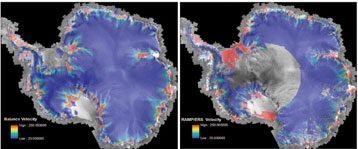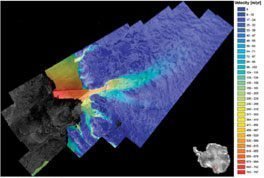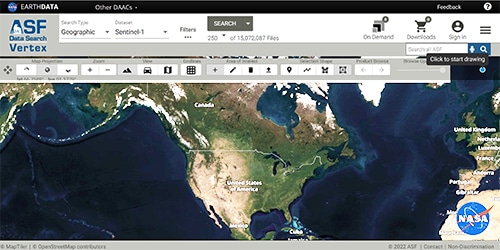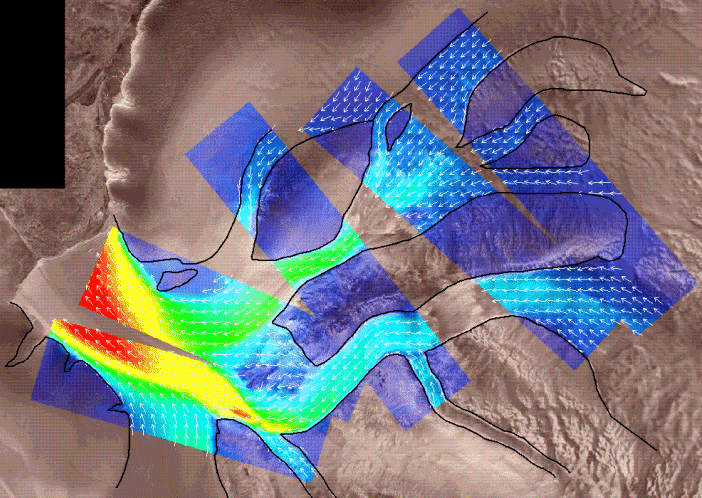Image of data retrieved from AMM-1 RAMP.
by Kenneth Jezek
The RADARSAT-1 Antarctic Mapping Project (RAMP) was conceived in the early 1980’s by Stan Wilson, Bob Thomas, and Bill Townsend. The idea developed as part of negotiations over participation by NASA in the Canadian Space Agency’s (CSA) RADARSAT-1 project. Both Ed Langham at CSA and Shelby Tilford at NASA reacted favorably to the exciting concept, and two complete mappings of the Antarctic were included in the Memorandum of Understanding.
Recognizing the importance of radar mapping of polar ice sheets, Frank Carsey and Ben Holt, both of the Jet Propulsion Laboratory (JPL), prepared a brief report titled “Mapping Antarctica and Greenland with Shuttle Imaging Radar” (Carsey and Holt, 1985). The report sketched the scientific objectives for radar mapping of ice sheets and discussed a possible mapping campaign to be conducted as part of the SIR-B reflight. The advantage of the shuttle project was provision of data much sooner than the planned free-flying SARs. The key technical innovation was to launch the shuttle from Vandenburg Air Force Base so as to place the shuttle in an 88-degree inclination orbit. SIR-B was planned for launch in March 1987 and the crew was to include Kathy Sullivan, who worked with Carsey, Holt, Ken Jezek and the science team to prepare for the mission. With the report as background material, Carsey and Holt convened a meeting at JPL during October of 1985. The meeting was followed-up by a late 1985 draft proposal and, with help from the National Science Foundation (NSF) and Ian Whillans, the installation of several corner reflectors in Antarctica during that austral summer. Regrettably, the SIR-B reflight plans were abandoned when, after the catastrophic loss of the Challenger Space Shuttle in January of 1986, NASA designated the Kennedy Space Center as the sole location for future shuttle launches. That decision precluded launch of the shuttle into polar orbit. Nevertheless, Carsey and Holt’s effort laid the foundation for understanding the operational constraints behind a future mission.
At about the same time, NASA was solidifying plans for the construction of a northern ground receiving station. After consideration of several sites, NASA selected the Geophysical Institute (GI) of the University of Alaska Fairbanks (UAF) as the optimal site based on the station mask which stretched far out over the western basin of the Arctic Ocean. NASA also recognized the mutual benefits of colocating a satellite station within the GI’s already strong research environment. Much of the scientific focus of the Alaska SAR Facility (ASF) at that time was concentrated on Arctic sea ice as set forth by the Program for International Polar Oceans Research (PIPOR). The agencies continued background plans for mapping the polar ice sheets in anticipation of the early 1990’s launch of the European Space Agency ERS-1 satellite, but with an eye toward the additional capabilities expected for JERS-1 and, in particular, RADARSAT-1 (NRC, 1989).
In November 1990, The Byrd Polar Research Center (BPRC) hosted a conference to examine capabilities for collecting data over the southern continent and the surrounding ice covered waters. The main objectives of the meeting were to review potential science payoff from a major SAR mapping campaign and to look at limitations associated with the planned instrument suite of that time. The report concluded that given constraints on downlink capabilities (ERS-1, for example, had no onboard recording) and limitations in expected onboard tape recorder data volume, Antarctic coverage could be optimized by developing a ground receiving station at McMurdo Ground Station Antarctica (MGS). The report recommended that the station operations be modeled after ASF and that data received at the MGS be transferred to ASF for processing, distribution and archival. The recommendation was accepted by NASA and the NSF in 1992, and the McMurdo Ground Station became operational in 1994.
With the successful launch of ERS-1 in 1991 and the beginning of routine operations at ASF, the science community began to concentrate on plans for a complete mapping of Antarctica using RADARSAT-1. BPRC hosted a second meeting in March 1993 to prepare more detailed requirements for the proposed mission. The meeting was attended by Martha Maiden who represented NASA’s Pathfinder Project, members of the glaciological community, representatives from CSA and the four partners in the RAMP activity, namely BPRC, ASF, Vexcel and JPL. John Crawford from JPL and Ed Oshel from Ohio State University (OSU) provided the first estimates of acquisition duration at the meeting. They estimated that 24 days were required to fulfill mapping and stereo mapping goals. They later found that about 17 days were required to meet the mapping requirements. This estimate was later refined by Crawford who concluded that the acquisition period required a minimum of 18 days.
Mission preparations intensified during the mid-1990’s and detailed plans were developed during a series of meetings between the team members, NASA and CSA. The plan was refined to specify acquisitions at both ASF and MGS as well as at Canadian Ground Receiving Stations. ASF would be responsible for accumulating and for processing signal data to images using SAR processing systems developed by JPL. OSU would construct the image mosaics using software developed by John Curlander, Lynne Norrikane and Bob Wilson from Vexcel. JPL would develop the mission plan and together with OSU would be on hand to monitor and modify the acquisition plan as needed during the mission. With the successful launch of RADARSAT-1 in 1995, final responsibilities for each aspect of the mapping plan were formalized in a series of requirements documents in early 1996, and which aimed at a mapping mission during the fall of 1997.
In 1996, Erick Chiang of the Office of Polar Programs of the NSF arranged for Frank Carsey to visit the McMurdo Ground Station. The objective was to observe the overall operation of the facility, and also to discuss preparations for a 1997 imaging campaign. Ken Jezek and Robert Onstott joined Carsey on the trip to install radar transponders at the McMurdo and South Pole Station and get a better understanding of operations at MGS. The NSF transponders and other ground control would be used to constrain the orbit ephemeris to be used in later data processing.
Vanessa Griffin and Dick Monson, both from NASA, and Ken Jezek traveled to St. Hubert in January 1997 for the RADARSAT-1 Antarctic Imaging Campaign kick-off meeting. George Harris was identified as the CSA Project Manager under Dan Showalter. Ken Lord and Ken Ashworth discussed initial thinking on the implementation of the imaging campaign which required a rotation of the satellite for southerly observations. The objective of the meeting was the formal go-ahead from Rolf Mamen and Ed Langham. In addition, operational procedures were discussed for mission planning, rehearsals and contingencies.
Refinements of John Crawford’s acquisition plan and project rehearsals continued throughout the summer of 1997. Crawford and Rejean Michaud, with help from Nettie La Belle-Hamer and Jean Muller, assumed most of the responsibility for the mission planning preparations under the watchful eye of Ken Lord. Planning for receipt of data at ASF and MGS was organized by Carl Wales of ASF with much of the daily responsibility falling on Marc Forbes, Dick Harding and Greta Reynolds. Tom Bicknell, Dave Nichols, Pat Liggett and Dave Cuddy from JPL were responsible for SAR processor preparations. Jason Williams from ASF and Satish Srivastiva from CSA were responsible for calibration preparation and Jamie Marshner was responsible for simulations and testing of the end-to end system at ASF. Verne Kaupp led the ASF science team preparations along with Ben Holt. Prasad Gogineni, was responsible for overall management of the effort and Paul Ondrus was responsible for day-to-day crisis management.
Final preparations for the 1997 imaging campaign included positioning people at various stations across the northern hemisphere. Katy Farness and Biyan Li from OSU were stationed at the Gatineau and Prince Albert Ground Stations to monitor downlinks at those sites. Ben Holt, Rick Forster, Frank Carsey, Rick Guritz and Sue Digby were stationed at ASF for similar work and to conduct preliminary science analysis. Rick Austin joined the mission planning team to help with replanning work. Hong Xing Liu and Hong Gyoo Sohn remained at OSU to help with acquisition summaries and swath mapping.

Satellite rotation began on September 10 and proceeded as planned. Antarctic data acquisitions began within a few days of the Antarctic maneuver and lasted until October 20, when satellite orbit maintenance requirements dictated that the satellite operators prepare for the return to right-looking mode on October 23. Processed image data from the acquisition phase of the 1997 campaign (over 2170 minutes of SAR signal data) have been mosaicked to achieve the primary goal of producing the first, high-resolution, SAR image map of the entire Antarctic continent (Figure 1). The project also acquired 24-day, exact-repeat observations because of the contingency pre- and post-nominal plan acquisitions. Those data have been analyzed to extract surface velocity and topography data using radar interferometric techniques. The resultant velocities are critically important for studying ice-sheet dynamics and assessing ice-sheet mass balance, which in turn is a key parameter influencing global sea level.
Several years of data processing followed the 1997 imaging campaign. By mid-1999, processing was sufficiently complete that the RAMP team began to inquire about the anticipated second mapping mission. Kim Partington, at NASA HQ, endorsed the idea and project planning began in January 2000. The scope of the new project, deemed the Modified Antarctic Mapping Mission (MAMM) by Rolf Mamen, was different from the 1997 Antarctic Imaging Campaign. MAMM would focus on interferometric coverage north of 80 degrees south latitude. The complex mission plan was developed by John Crawford and Rick Austin from JPL and provided to Stephanie Ruel who led the CSA mission planners. Dick Monson along with Ian Joughin and Ramachand Bhat provided guidance on interferometric constraints on orbit maintenance to Greg Hammel of CSA who was responsible for the difficult orbit maintenance maneuvers required for this mission. Richard Carande, Xiaoqing Wu and James Miller from Vexcel worked to develop automated software for processing the huge volumes of interferometric data. Verne Kaupp, ASF director at the time, added Jeremy Nicoll, Paul Brown, and Dave Fluetsch to the ASF team. Bill Potter from Goddard Space Flight Center (GSFC) helped with crisis management. With the concurrence of NASA and of Surendra Parashar from CSA, the team prepared for a second acquisition plan starting in September 2000.
MAMM began on September 3, 2000 and lasted until November 14, 2000, an interval corresponding to three repeat cycles. Data were acquired so that, where possible, the position of features on the glacier (such as crevasses) could be compared between the 1997 and 2000 data sets to measure point velocities. Second, and the real challenge of MAMM, was to acquire interferometric data to estimate velocity fields. The second approach required the use of RADARSAT-1 Fine and Standard Beams, and the unprecedented control of the spacecraft orbit and attitude. As the mission unfolded, CSA spacecraft engineers demonstrated their ability to navigate the satellite in the manner dictated by the science requirements. The outcomes of the MAMM effort were a second high resolution map of much of Antarctica (Figure 1) and extraordinary observations of glacier motion captured over three, 24-day, RADARSAT-1 cycles (Figure 2). These data provide an unprecedented opportunity to study many of Antarctica’s fast glaciers, whose extent was revealed through the Antarctic Mapping Mission (AMM-1) data.


With mounting evidence for rapid changes in the polar regions, follow-on measurements were requested by the RAMP team and then approved by Waleed Abdalati at NASA HQ and Nettie La Belle-Hamer, the current Alaska Satellite Facility Director. These were scheduled in 2004 and designed to be coincident with the MAMM data over the target areas. The MiniMAMM mission was planned by Michelle Harbin and Vicky Wolf of ASF. MiniMAMM acquired additional interferometric data over four fast glacier areas around Antarctica. The interferometric results from this data set are of a very high quality because the acquisitions occurred off the peak of solar activity (Figure 3). This means there is less ionospheric distortion in the data.
The success of the RADARSAT-1 program in general and the achievements of the RAMP project in particular are the successes of the many people deeply committed to the venture. As of this writing and through the efforts of many, RADARSAT-1 continues to provide exceptional data about the Earth from pole to pole. Hopefully, a combination of old and new faces will be willing to try it again with RADARSAT-2!
References
Carsey, F. and B. Holt. 1985. Mapping Antarctica and Greenland with Shuttle Imaging RADAR. Informal white paper, JPL, 18 p. NRC, 1989.
Propects and Concerns for Satellite Remote Sensing of Snow and Ice. National Academy Press, Washington, D.C., 44 p. Science Working Team. 1991.
McMurdo SAR Facility: Report of the Ad-Hoc Science Working Team. K. Jezek and F. Carsey, eds, BPRC Technical Report 91-01, 31 p.




